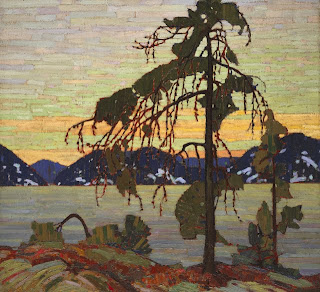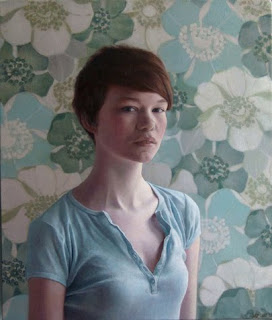
Gilbert Stuart Newton, Yorick and the Grisette
Tate Gallery, London England.
Stuart Newton is one of those lucky artists who are claimed by three nations as their own. He was born in Halifax, Nova Scotia in 1797 before Canada became a country, and he died in Wimbledon in England in 1835, subsequently he is called "British", and his works can be found in the Royal Academy of Arts in London, England.(He lived most of his life in England)
After his father died, his mother moved with her children to Boston and with that the Americans get their chance to claim him as their own. He studied for a year in Italy, but it seems that the Italians passed on their opportunity to claim him. Maybe he couldn't speak Italian well enough. Who really knows? Anyway, all these comments were pulled from the article below. And, in case you are reading this from another country, it would be remiss of me not to correct Half-fax. Mercy no. His birth was not done by halves and it was long before the creation of the fax machine. Nova Scotians can rest easy for he was born in their capital city of Halifax.
NEWTON, Gilbert Stuart, artist, born in Half-fax, Nova Scotia, 20 September, 1797 ; died in Wimbledon, England, 5 August, 1835. His father, Edward, was British collector of customs at Halifax; his mother was the daughter of a Scottish loyalist named Stuart, who fled from Rhode Island to Halifax, and thence to England, at the beginning of the Revolution. After the father's death Mrs. Newton removed with her family to the neighborhood of Boston, Massachusetts, about 1803. Gilbert left Boston when yet a youth and went to Italy, where he studied a year. He had painted some pictures and portraits before leaving home which excited attention and were thought very promising, and while in Italy he produced a portrait of an official which was much admired, but he decided to go to England. In Paris, on his way, he met Washington Allston, Sir David Wilkie, and Charles R. Leslie, and returned with Leslie to England. He was admitted as a student at the Royal academy, elected an associate in 1828, and an academician in 1831. His career in England was one of brilliant success. Upon his first arrival in that country he and Washington Irving had lodgings together in Langham place. Irving writes in 1824 to Leslie: " When you see Newton, remember me affectionately to him. I often look back with fondness and regret to the times we lived together in London in a delightful community of thought and feeling, struggling our way onward in the world, but cheering and encouraging each other. I find nothing to supply the place of that heartfelt fellowship." In 1831 Mr. Newton was ill, and, as his physician urged his taking a voyage, he sailed for the United States in October of that year. The following August he married in Boston, and he returned to England with his wife in October, 1832. Nearly three years later he died, leaving his widow and one daughter. He was buried in the cemetery of the village church at Wimbledon. A monument, executed by Sir Francis Chantry, was raised to him by a few of his fellow-academicians, bearing the inscription : " To Gilbert Stuart Newton this monument is raised by a few friends who admired him as an artist and loved him as a man." What is to be said of Mr. Newton as a man may be read in the letters of Leslie and Washington Irving that are quoted in the " History of the Arts of Design," in a notice of Mr. Newton by William Dunlap. Dunlap shows some irritation that Newton should have considered himself an Englishman, but he was certainly such by birth and parentage, and his whole career was in England. He took to portraiture at first, mainly, it appears, because he disliked the labor of study required for effective genre painting, in which direction his greatest talent lay. The remonstrances of his friends, however, particularly Washington Irving, had their effect, and he soon afterward produced his first subject picture, "A Poet Reading his Verses to an Impatient Gallant." He had an extraordinary eye for color, and possessed considerable humor, excelling particularly in the illustration of scenes from Molidre, "Gil Blas," etc. Besides portraits, he painted about sixty pictures, including "Falstaff escaping in the Buck-Basket," "Girl at her Devotions," "The Adieu," "The Dull Lecture," " The Duenna," "The Late Player," in the New York historical society's rooms, and "The Trunk Scene in 'Cymbeline.'" Many of them have been engraved. His portraits include likenesses of Sir Walter Scott at Abbotsford, Thomas Moore, Sydney Smith, Henry Hallam, and Washington Irving. While Mr. Newton was in this country in 1831-'2 he painted eight small portraits. His "Dull Lectare" is in the Lenox library, New York city. Washington Irving described this picture, at the request of the artist, in these lines: " Frostie age, frostie age, Vain all your learning! Drowsie page, drowsie page, Evermore turning!Young head no lore will heed, Young heart's a reckless rover;Young beautie, while you read, Sleeping, dreams of absent lover."
To view the source of this article on Famous Americans net please click here.











